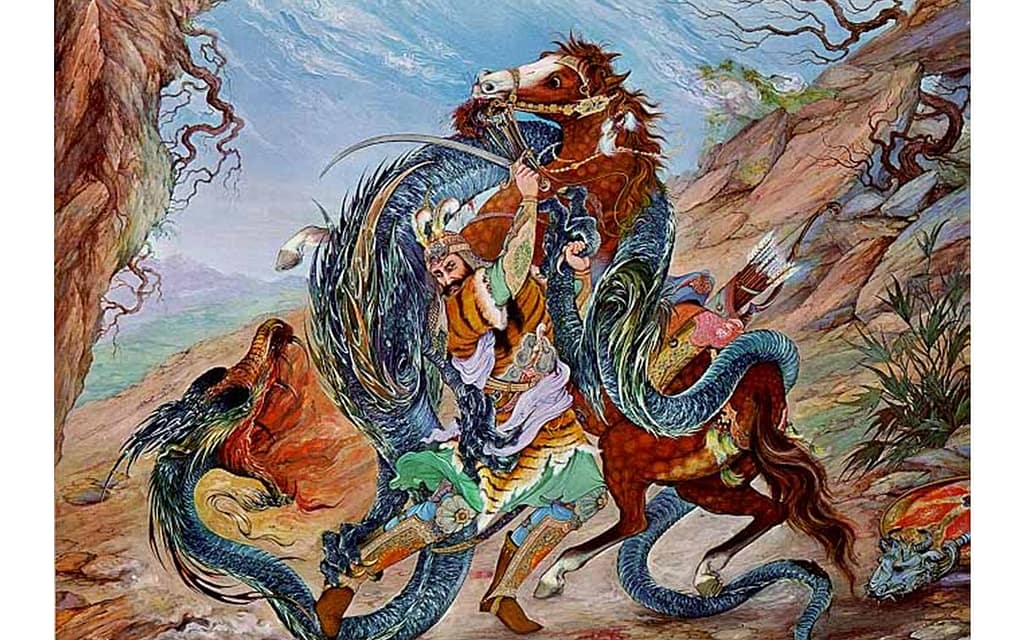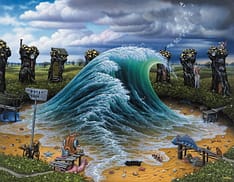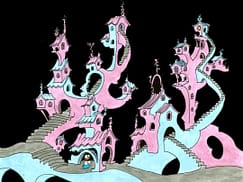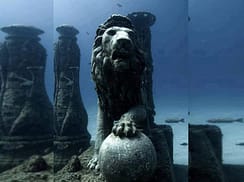In 977 AD, a Persian poet named Ferdowsi began on a grandiose poetic journey that would take him 33 years to complete. He used ancient Persian tales which had been told from generation to generation for several millennia as the source for writing his poems about epic kings and heroes and about mythical creatures and adventures. This resulted in the creation of the epic which in Persian is called Shahnameh or translated The Book of Kings, the longest poem ever written in history. Ferdowsi’s great aim was to revive the ancient Persian culture, mythology and language after the invasion of the Islamic Caliphate of the Arabs.
The Life of Ferdowsi
Ferdowsi was born in 935 AD in the city of Tus located in the modern day province called Khorasan in northeastern Iran. At this time, the Samanid dynasty had restored native Persian rule on Iranian territories as the second post-Islamic Persian empire after the eastern parts of the Islamic Caliphate had been liberated from the Arabs in 861 AD. Ferdowsi came from a line of wealthy noble families which generation after generation inherited the title dehqan. The dehqans were among the social top class and were the leaders of communities and owners of land. By the time Persians were violently forced to become Muslims after the invasions, the dehqans converted to Islam not for following Islam itself, but mainly for using their social authority for preserving the ancient Zoroastrian culture of Persia. For centuries, the dehqans were the preservers of the traditional customs, culture and literature of ancient Persia and hence acted as fundamental factors for the survival of Iranian identity. Dehqans were often able to afford the best education which resulted in Ferdowsi gaining considerable knowledge in literature. He was closely tied to the ancient Persian culture and studied ancient scripts which inspired his poetry.
In the year 977 AD, a shift in power had been initiated in Persia with the end of the Samanid dynasty and the beginning of the Ghaznavid dynasty. Ferdowsi became a poet of the Ghaznavid royal court and due to the exquisite and superb quality of the poems that he wrote, the king entitled him Ferdowsi. This name derives from the Persian word pardisi or fardisi which means from paradise. With the new title given to him by the king, he began writing Shahnameh which would become the greatest poetic journey of his life and one of the greatest works of poetry in the world.
Statue of Ferdowsi in Tehran, Iran (http://toos051.persiangig.com/new_folder/Ferdowsi_Statue.jpg)
Shahnameh – The Epic
Prior to writing Shahnameh, Ferdowsi collected literary material from ancient sources such as from the middle Persian Pahlavi work named Khodaynameh, which translates to Book of God in English. The documentation of this ancient work was ordered by the Sassanid king Anushiravan and was based on historical facts documented by Zoroastrian priests as well as legendary accounts of mythical eras written in Avesta, the holy book of the Zoroastrian religion. Some ancient sources has stated that the Persian literary tradition of recording royal events and mythical stories has existed at least from the time of the Achaemenid era in the 6th century B.C, although the stories are thousands of years older and have been transferred verbally for generations. Many of the stories are very similar to ancient Indo-Iranian/Aryan stories, indicating the close connection of Persians to their Aryan heritage.
Ferdowsi divided the timeline of Shahnameh into three major periods; the mythical era, the heroic era and the historical era. A very brief description of each era follows:
The mythical era comprises of poems about the creation of the world and of the first man named Keyumars who became the first king. Keyumars’s grandson Hushang discovered fire and established the yearly fire festival Sadeh. Jamshid the shepherd, who became a great king in the favor of God named Ahura Mazda, ruled the lands with prosperity and struck down the evil demons named deev. Jamshid also established the Persian New Year Nowruz meaning New Day which is celebrated on 20 March every year. The child of the devil Ahriman, the evil serpent man Zahhak, killed Jamshid and became the new king. Ahriman kissed Zahhak’s shoulders and out of his shoulders, two snakes grew out. Zahhak tried to cut off the snakes but they always grew out again, he was cursed. The snakes required to be fed with fresh brains of young boys every day. Zahhak therefore fulfilled their requests in fear of being killed by the snakes. This led to the uprising of the blacksmith Kaveh who refused to sacrifice his last son. Kaveh started the uprising and made a banner out of his leather apron by putting it on top of a spearhead. With the help of the people and a prince named Fereydun who eventually became king, they captured Zahhak and chained him to mount Damavand in northern Iran, the highest volcano in all of Asia and the highest peak in the Middle East. There are stories about king Fereydun and his three sons Salm, Tur and the youngest Iraj. They inherited the three corners of the world after their father died and Iraj inherited the empire of Persia. This resulted in jealousy of the two older brothers towards their younger brother Iraj and stories about epic wars between the brothers are told. Iraj was killed by Tur and Iraj’s grandson Manuchehr became the king of Persia to avenge his grandfather’s death.
Zahhak bound on mount Damavand. Baysungur’s Shahnama, 1430. (Wikimedia Commons)
The heroic era comprises of poems about legendary love stories, epic heroes and battles. A man named Sam, who was the fellow companion of king Manuchehr, became the father of a child who he named Zal. Zal was born albino with white hair and pale skin. Manuchehr thought the child was demonic and Zal was therefore rejected as an infant and put on top of mount Damavand to die. Luckily, the loving and wise mythical bird Simorgh who nested in the mountain, found Zal and nourished him. Simorgh had experienced three ancient world destructions from which she harbored the knowledge of all ages. When Zal had grown up, he left the custody of Simorgh. Simorgh gave him three golden feathers from her wing which Zal could burn in a sacred fire whenever he needed help from Simorgh. Zal met his love, princess Rudabeh and she fell in love with Zal’s unique features, charisma and wisdom. They eventually married and Rudabeh gave birth to a boy who they named Rostam. Rostam grew up to become the greatest hero of Persia. He went on seven adventures called the Seven Quests of Rostam, where he together with his loyal and strong horse Rakhsh fought battles with the White demon, The beautiful Sorceress, the Dragon, the Lion and various kings. Rostam found his love, princess Tahmineh and they became parents to a boy named Sohrab. Rostam gave Sohrab a bracelet as a gift when he was an infant before leaving him and Tahmineh. Sohrab grew up without ever seeing Rostam until several years later when the armies of Rostam and Sohrab met in a battle. Father and son did not know each other until Rostam fatally wounded Sohrab in a duel. It was then, while Sohrab was dying in his arms, that Rostam noticed the bracelet around Sohrab’s neck. Rostam then tragically realized that he had killed his own son. The legendary love story is also told about Bijan, the son of a famous knight from Persia and Manijeh, the princess of an empire called Turan in modern day Central Asia, which mythologically was the greatest enemy of Persia. This love story ultimately resulted in an epic war between the two empires.
Iranian miniature painting of the mythical bird Simorgh (http://nadiaartgallery.com/wp-content/uploads/2013/07/simorgh.jpg)
The historical era comprises of historical accounts starting from the dynasty of the Parthian kings after Iranian territories had been freed from Greek and Macedonian rulers. A lot of the focus is put on the succeeding dynasty of the Sassanid emperors and the stories regarding this dynasty are exquisitely told. Shahnameh ends with the Islamic Arab conquest of Persia in 651 AD. Ferdowsi poetically described this event as a major disaster over what he calls the arrival of “the army of darkness”.
The Legacy of Ferdowsi
After 33 years at the age of 71, Ferdowsi finished the writing of Shahnameh on 8 March 1010 AD and in 1020 AD, Ferdowsi died at the age of 82. He was buried in his birth place Tus. Shahnameh contains 62 stories, 990 chapters and 60 000 rhyming couplets which makes it the longest poem in the history of literature, a work seven times longer than the Illiad of Homer. Ferdowsi wrote his work entirely in classical Persian which is still spoken today by Iranians and people related to the Iranian culture in countries once part of Greater Iran. It was a linguistic renaissance considering that the Persian language was officially banned in Persia by the Arab rulers for almost 200 years. Today, Shahnameh is a common book in Iranian households and it is the national epic of the Persian speaking world. The epic stories of this masterpiece influenced the literature of Asia for centuries and the stories are enthusiastically told to this day. The philosophical message of Shahnameh is that since the world is transient and everyone is merely a passerby, one is wise enough to avoid cruelty, lying and other evil deeds. Instead one should strive for justice, truth and order which brings happiness, ease and honor. Ferdowsi put lifelong dedication and sacrificed a lot to complete his work. Ferdowsi’s writing style is that of a superb poet’s. His epic language is rich, moving and lavish so that it truly enchants the reader. He is remembered as the greatest of the Persian poets who with the power of the pen rescued and revived the Persian language, culture and heritage.
Ferdowsi’s tomb in Tus, Iran (Wikimedia Commons)
Below are the words of Sohrab spoken to Rostam as he did not know he was dying in the arms of his father. From Shahnameh – The Persian Book of Kings, translated by Dick Davis:
I brought this on myself, this is from me,
And Fate has merely handed you the key
To my brief life, not you but heaven’s vault –
Which raised me and then killed me – is at fault.
Love for my father led me here to die.
My mother gave me signs to know him by,
And you could be a fish within the sea,
Or pitch black, lost in night’s obscurity,
Or be a star in heaven’s endless space,
Or vanish from the earth and leave no trace,
But still my father, when he knows I’m dead,
Will bring down condign vengeance on your head.
One from this noble land will take this sign
To Rostam’s hands, and tell him it was mine,
And say I sought him always, far and wide,
And that at last, in seeking him, I died.
Featured image: Rostam the hero fighting the Dragon in the Seven Quests of Rostam. Iranian miniature illustration from Shahnameh (iranonline.com)










